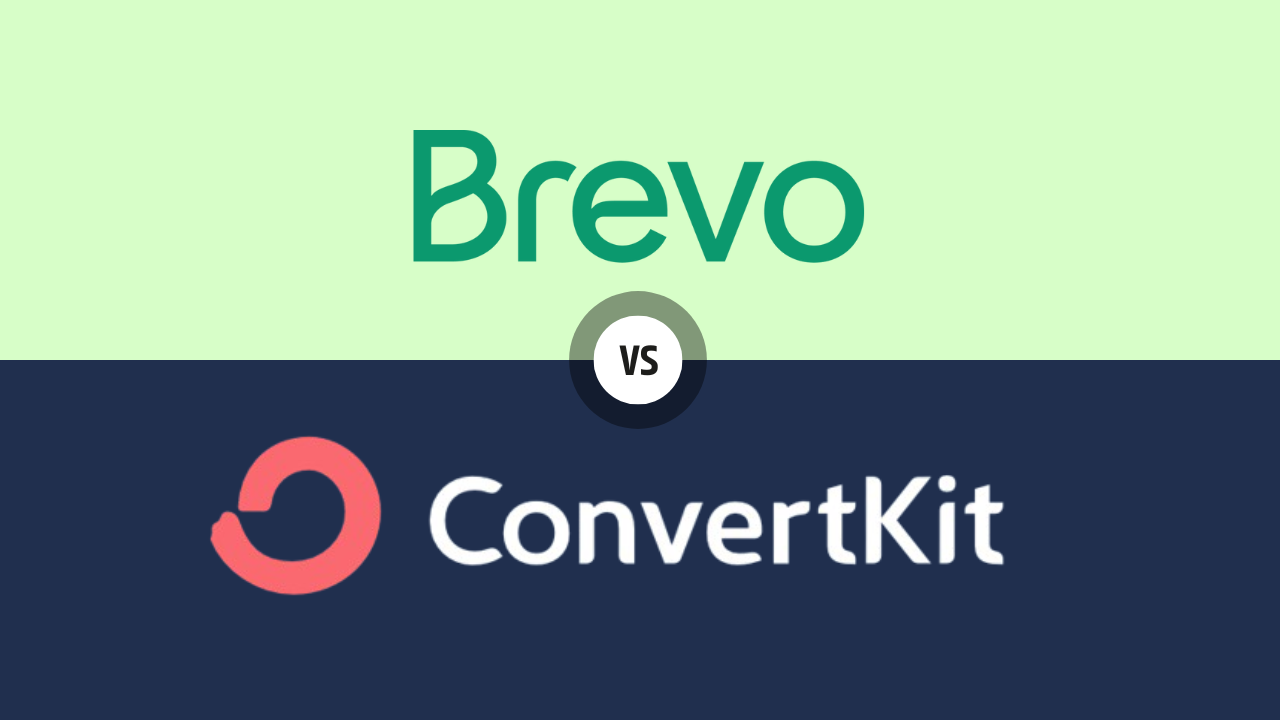Overview of Brevo vs ConvertKit
When deciding between Brevo vs ConvertKit for your email marketing needs, it’s important to understand what each platform offers and how they align with your goals. Both are popular tools with unique strengths, but which one is the right fit for you? In this blog post, we’ll dive into a detailed comparison of their features, pricing, ease of use, and more to help you make an informed decision. Whether you’re a business looking for advanced capabilities or a creator seeking simplicity, this guide will provide the insights you need to choose the best option for your email marketing strategy.
Table of Contents
Ease of Use
Brevo provides a straightforward interface that is especially friendly for beginners. Its drag-and-drop email editor is easy to navigate, allowing users to design beautiful emails without any coding skills. Additionally, Brevo includes helpful tutorials and tips throughout the platform, which is a plus for those new to email marketing.
ConvertKit, on the other hand, focuses on simplicity and functionality. It offers a clean and minimalistic dashboard that makes it easy to find the tools you need. ConvertKit is designed with creators in mind, offering features like visual automation builders that simplify the process of setting up automated email sequences.


Both Brevo and ConvertKit excel in providing user-friendly experiences, but they do so in different ways. Brevo focuses on robust, easy-to-use tools with plenty of guidance, while ConvertKit emphasizes simplicity and streamlined workflows for content creators. Depending on your needs, either could be a great choice.
Email Automation Capabilities
Brevo provides a comprehensive automation system that allows you to create detailed workflows. You can set up triggers based on user actions, such as email opens or clicks, and automate responses accordingly. This flexibility helps in creating highly personalized email sequences that can improve engagement rates.
ConvertKit also excels in automation, offering a visual automation builder that makes it easy to design complex workflows. This feature is handy for creators who need to manage multiple email sequences and funnels. ConvertKit simplifies the process by allowing you to see the entire workflow visually, making it easier to adjust and optimize.


When comparing Brevo vs ConvertKit, both platforms offer powerful automation capabilities, but their approaches differ. Brevo provides detailed customization options for triggers and actions, while ConvertKit offers an intuitive visual builder ideal for managing complex workflows. Depending on your specific needs, either platform can significantly enhance your email marketing strategy.
Integrations and Compatibility
Brevo supports a wide range of integrations, including popular tools like Shopify, WordPress, and Zapier. This extensive compatibility allows you to connect Brevo with your e-commerce platform, CMS, and other marketing tools effortlessly. Additionally, Brevo offers API access, enabling developers to create custom integrations tailored to their needs.
ConvertKit also provides numerous integrations, focusing on tools that creators and small businesses frequently use. You can easily connect ConvertKit with platforms like Teachable, WooCommerce, and Leadpages. The platform’s native integrations are designed to help you streamline your workflow and maximize your productivity.


When comparing Brevo vs ConvertKit, it’s clear that both platforms offer strong integration capabilities, but they cater to slightly different audiences. Brevo provides broader integration options suitable for various business needs, while ConvertKit focuses on integrations that benefit creators and entrepreneurs. Both platforms ensure compatibility with essential tools, making them versatile choices for your email marketing efforts.
Customer Support
Brevo provides 24/7 customer support through multiple channels, including live chat, email, and phone. This round-the-clock availability is particularly beneficial for businesses operating in different time zones. Additionally, Brevo has a comprehensive help center with articles, tutorials, and guides to help users troubleshoot common issues independently.
ConvertKit offers customer support via email and live chat during business hours. While not available 24/7, the support team is known for being responsive and knowledgeable. ConvertKit also features an extensive knowledge base and a community forum where users can ask questions and share tips with one another.
When comparing Brevo vs ConvertKit in terms of customer support, both platforms have strong offerings, but their approaches differ. Brevo excels with its 24/7 support and multiple contact options, making it a great choice for those who need constant access to help. ConvertKit provides reliable support during business hours and fosters a strong community for additional assistance. Both platforms ensure that users have the resources they need to resolve issues efficiently.
Reporting and Analytics
Brevo provides detailed reports on key metrics such as open rates, click-through rates, and bounce rates. The platform’s analytics dashboard is user-friendly, allowing you to easily visualize data and identify trends. Brevo also offers advanced segmentation options, enabling you to analyze the behavior of specific subscriber groups and tailor your strategies accordingly.
ConvertKit offers robust reporting tools that focus on simplicity and clarity. The platform tracks essential metrics like open rates, click rates, and unsubscribes, presenting them in an easy-to-understand format. ConvertKit also includes a visual automation report, which allows you to see how your email sequences are performing and make adjustments to improve results.


When comparing Brevo vs ConvertKit in terms of reporting and analytics, both platforms provide valuable insights but cater to different needs. Brevo offers more advanced segmentation and detailed reporting, making it ideal for businesses that require in-depth analysis. ConvertKit focuses on straightforward, clear reports that are perfect for creators and small businesses looking to understand their email performance quickly. Both platforms ensure you have the data needed to refine your email marketing strategies.
Target Audience
Brevo is tailored for businesses of all sizes, from small startups to large enterprises. Its comprehensive set of features, including advanced segmentation, automation, and detailed analytics, make it a powerful tool for marketers looking to execute sophisticated email campaigns. Brevo is ideal for companies that need robust functionality and scalability to support their growing email marketing needs.
ConvertKit, on the other hand, is specifically designed for creators such as bloggers, podcasters, and online course instructors. The platform’s emphasis on simplicity and ease of use makes it perfect for individuals and small businesses who want to focus on content creation rather than complex marketing operations. ConvertKit’s visual automation builder and straightforward interface cater to users who need effective, easy-to-manage email sequences.
When comparing Brevo vs ConvertKit in terms of their target audience, both platforms cater to distinct groups. Brevo is a versatile choice for businesses seeking advanced email marketing capabilities and scalability. ConvertKit is best suited for creators who prioritize simplicity and ease of use in their email marketing efforts. Both platforms offer unique strengths, ensuring that users can find the right fit for their specific audience and goals.
Pricing and Plans
Brevo provides a range of pricing options starting with a free plan that includes basic email marketing features. As your needs grow, you can upgrade to paid plans that offer more advanced features, such as enhanced automation and detailed reporting. Brevo’s pricing is based on the number of emails sent and the features included, making it flexible for businesses of all sizes.
ConvertKit also offers a free plan that allows users to manage up to 1,000 subscribers with essential features. For more advanced capabilities, such as automated funnels and integrations, users can choose from several paid plans. ConvertKit bases its pricing on the number of subscribers, making it a straightforward option for creators who need to manage their audience effectively.


When comparing Brevo vs ConvertKit in terms of pricing and plans, both platforms provide competitive options. Brevo’s plans are versatile, catering to businesses that require flexibility in email volume and features. ConvertKit offers a simple, subscriber-based pricing model that is ideal for creators and small businesses. Both platforms ensure that users can find a plan that fits their budget and marketing needs.
Security and Privacy
Brevo employs robust security measures, including encryption protocols to protect data during transmission and storage. The platform is GDPR compliant, ensuring that user data is handled according to strict privacy standards. Brevo also offers advanced security features like two-factor authentication to add an extra layer of protection to your account.
ConvertKit also emphasizes security and privacy, with measures such as data encryption and secure servers to safeguard user information. The platform is fully compliant with GDPR, CCPA, and other major data protection regulations. ConvertKit provides users with clear guidelines on how to manage subscriber data responsibly and includes features like single sign-on (SSO) for enhanced security.
When comparing Brevo vs ConvertKit in terms of security and privacy, both platforms offer strong protections and compliance with key regulations. Brevo provides advanced security features like two-factor authentication, making it a solid choice for businesses with stringent security needs. ConvertKit ensures robust data protection and straightforward compliance, ideal for creators who want to maintain a high level of trust with their audience. Both platforms are committed to keeping your data safe and secure.
Pros and Cons
Brevo Pros:
- Feature-rich platform with advanced automation, segmentation, and analytics.
- Flexible pricing plans that cater to both small businesses and larger enterprises.
- 24/7 customer support is available through multiple channels.
- Extensive integrations with popular tools and platforms.
Brevo Cons:
- The wide range of features might feel overwhelming for beginners.
- Higher cost for advanced features compared to some competitors.
ConvertKit Pros:
- User-friendly interface that is easy to navigate, ideal for creators.
- Simple, clean email templates that help maintain high deliverability rates.
- Visual automation builder that simplifies the creation of complex workflows.
- Subscriber-based pricing model that’s straightforward and easy to understand.
ConvertKit Cons:
- Limited advanced features compared to other platforms like Brevo.
- Customer support is not available 24/7.
Conclusion: Which One Should You Choose?
If you’re a business that requires advanced features, detailed analytics, and flexible integrations, Brevo might be the better choice. It’s designed to handle complex campaigns and offers robust support to help you maximize your email marketing efforts. Brevo is also a great fit for businesses of all sizes, especially those that need scalability and customization.
On the other hand, if you’re a creator—such as a blogger, podcaster, or online educator—ConvertKit might be more aligned with your needs. Its user-friendly interface, visual automation builder, and straightforward pricing make it an excellent option for individuals and small businesses focused on content creation. ConvertKit simplifies email marketing, allowing you to focus more on your craft and less on the technical aspects.



